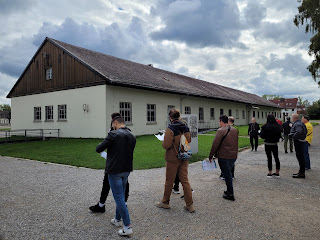Dakau was one of the first concentration camps built by Nazi Germany, and the longest running one, opening on March 22, 1933. The camp was initially intended to house Hilter's political opponents. It's located on the grounds of an abandoned munitions factory just outside the beautiful, medievel town of Dachau, Germany.
Heinrich Himmler opened the camp and enlarged the forced labor camp to include criminals, Jews, beggars, returning immigrants, homosexuals, gypsies, Jehovah Witnesses, and people with mental illnesses. The camp grew to include 100 subsiduary-camps located throughout southern Austria and Germany.
Prisoners lived in constant fear of brutality. They had long hours of hard labour, fed very little, and their drinking water was filthy. A prisoner would be severely punished for a minor infraction, or for helping someone in need. Their treatment was horrendous which included standing cells, pole hanging from their arms which dislocated the shoulders, and floggings. Dachau was not a death camp, but most prisoners eventually died of starvation, illness or torture.
Very little is left of Dachau now because the Nazi destroyed it at the near end of the war to hide they dirty deeds. It is now being rebuilt, but it is a huge area, where dozens of barracks, and other buildings once were. Only examples of the buildings will be finished.
Here is a map of where Dakau lies along with a few of its subsidiary camps.
This building held the more educated prisoners such a doctors, bankers, etc. The Nazi's used their skills to help their cause. Their treatment was slightly better and they were held in individual cells.
This empty area used to be filled with prisoner barracks.
A mote and an electric fence was used as a deterrent to prisoners contemplating escape, but many tried and a few succeeded. A prisoner was shot on the spot for placing one foot on the green grass between the road and the mote.
This building was on the other side of the mote. Inside is a gas chamber and crematoriums. This chamber of horrors was used for experimentation. I guess they played with dosages to see which amount was the most effective.
Two crematoriums. Eventually more were needed because bodies were piling up and mass graves couldn't be dug fast enough.
In the barracks, each bed held three prisoners. The prisoners lived in very crowded conditions, with absolutely no privacy.

















































